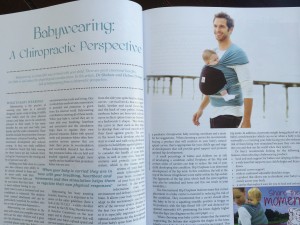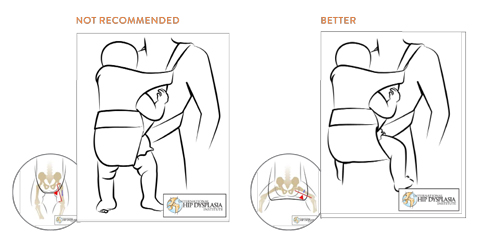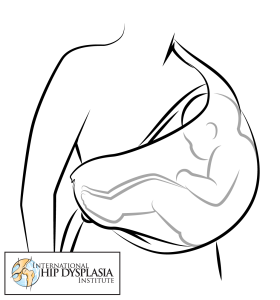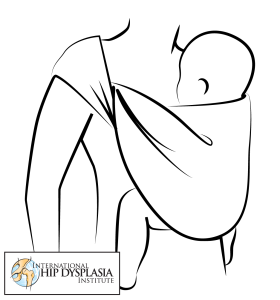Babywearing: A Chiropractic Perspective – first published in Nurture Parenting Magazine
Here is an article that Shalom and I wrote together. It was first published in the Winter 2014 issue of Nurture Parenting Magazine. A huge thank you to our colleague Dr Vanessa Barry (chiropractor and babywearing consultant) for her help with this article.
Babywearing is a beautiful way to bond with your child. There are great emotional benefits, but little is said about the physiological considerations. In this article, Dr Shalom Drimer and Helene Drimer look at babywearing from a chiropractic perspective.
WHAT IS BABY WEARING?
Babywearing is the practice of wearing your baby in a specially designed carrier, wrap or sling. It fulfills your baby’s need for close physical contact and helps you to be sensitively attuned to their needs. It has many benefits for you and your baby, your family and the wider community. These benefits include the promotion of secure attachment, enhanced bonding, healthy emotional development and reduced crying.1 In fact, one study published in Pediatrics found that baby wearing for three hours per day reduced infant crying by 54 percent in the evening and by 43 percent over all.2
Holding your baby close in a carrier can also enhance your ability to be closely attuned to them and to more easily read their cues. When you baby can let you know that they have a need without having to cry, their trust in you is increased and your confidence is enhanced. This deepens your mutual attachment and can be particularly beneficial for mothers who are at risk of postnatal depression.3 4
Babywearing can contribute to the ease with which you complete your work and care for older children and it gives you the freedom to navigate stairs and crowded places easily too. Babywearing is also a great way for you to connect with your baby as you enjoy walking in nature and on other adventures such as travelling.
For optimal physical and emotional wellbeing your baby requires an environment that is safe and loving. One in which their needs are met, reassurance is provided and protection is given from the external world. Babywearing contributes to meeting all of these needs. When your baby is carried they are in tune with your breathing, heartbeat and movements and this stimulation helps them to regulate their own physical responses. Babies with special needs and premature babies often have sensitive nervous systems that can make them prone to overstimulation and overwhelm. Research has shown that premature babies who are held and touched regularly gain weight more rapidly and are healthier than premature babies who are not.5
Babywearing has many amazing benefits, however, it is important to be aware of the safety guidelines (have a look at the T.I.C.K.S. below – a safety checklist devised by the UK Sling Manufacturers & Retailers Consortium) and to choose a carrier that will support your baby’s optimal spinal and nervous system development.
CARING FOR YOUR BABY’S SPINE
Your baby’s spine is not just a miniature version of an adult spine. If you look at your spine from the front, it appears straight, however when viewed from the side your spine has four distinct curves – cervical (neck), thoracic (upper back), lumbar and sacral (lower back and the back of your pelvis). However, newborn babies are born with only one curve in their spines (you can think of it as a backwards C-shape). They develop the curve in their neck as they begin to develop their cervical muscles to lift their head against gravity. The curve in the lower back develops when they start to crawl and walk using developing muscles to hold them against gravity.7, 8, 9
When babywearing it is important to consider the health of your baby’s spine, as well as your own. Your spine contains and protects your nervous system, which is the master control system of your body. It sends information from your brain to every cell of your body (via your nerves). It also receives information from your environment and delivers it back to your brain. It allows your body to constantly adapt to the environment you live in. 60% of the nervous system develops in the first two years of your baby’s life, so it is especially important to provide optimal conditions for the development of your baby’s spine from birth through infancy and beyond.
CHOOSING YOUR BABY CARRIER
So how do you choose the safest and most comfortable baby carrier from all the babywearing products available? We asked Dr Vanessa Barry – a paediatric chiropractor, baby wearing consultant and a mum for her suggestions. When choosing a carrier she recommends buying a product that will conform to your baby’s natural spinal curves, that is appropriate for your child’s age and stage of development, that will provide good support and promote optimal hip development.
A small percentage of babies and children are at risk of developing a condition called Dysplasia of the Hip and certain styles of carriers can help to reduce the risk of your child developing this condition. Hip Dysplasia is an abnormal development of the hip joint. In this condition, the ball at the top of the femur (thighbone) is not stable within the hip socket. The ligaments of the hip joint, which hold the joint together, may also be stretched and loose and this can result in joint instability.11
The International Hip Dysplasia Institute states that correct placement in a baby carrier is essential in reducing the risk of this condition. They recommend that a carrier should allow the baby to be in a squatting straddle position (a froggy or M position), with the hips flexed 100-110 degrees and abducted (or opened outwards) 45 degrees, positioning the knees slightly higher than the hips (see diagram below). 10, 12
When choosing your baby carrier, ensure that the material supporting the bottom also supports the thighs to the knee. Ideally, your baby should always be carried facing inward. This supports the natural C curve of your baby’s spine. Carrying your baby facing outward, places their spine into a more extended or straight position (they lose their C shape), which can place undue stress on their spine. Supporting the thighs in an inward facing position also prevents overstretching of the hip joints. In addition, it prevents weight being placed on your baby’s crotch/testicles (which can occur when a baby is facing outwardly).10 12 Carrying your baby facing you also reduces the risk of them being over stimulated because they can snuggle into you and shut out the world when they need to.
Dr Barry recommends looking for the following key features when selecting a babywearing product:
- head and neck support for babies and sleeping children.
- a wide base that supports your child’s thighs and flexes their knees.
- postural-curves support.
- wide or cushioned adjustable shoulder straps.
- a product that allows you to distribute your baby’s weight evenly across your body.
- a carrier that makes it easy for you to load and unload your baby.
- and one that allows you to keep your spine in a neutral position.10 This will help you to take care of your own spine and to avoid spinal injuries from baby wearing.
CONSIDERATIONS WHEN USING SLINGS
The Hip Dysplasia Institute also provides some guidelines to protect your baby’s delicate hips when using slings in the cradle position. In this position your baby’s knees are held close together and according to the Institute, this is not an ideal position for optimal hip development. The risk of hip dysplasia or dislocation is greatest in your baby’s first few months of life. By six months of age, their hips are more developed and the ligaments are stronger, so they are less susceptible to developing hip dysplasia.12 Therefore, it may be safest not to use a sling in the cradle position if your baby is younger than six months.
It is also important if you are using a sling in the cradle position to ensure that your baby can breathe freely. Parents sometimes assume that if their baby has difficulty breathing they will fuss or cry and while this might be true for the majority of infants, babies with weak neck control, such as newborns (0-4 months), babies born prematurely or infants with low muscle tone or developmental delays may not be able to communicate their distress as easily.
When placing your newborn in a carrier or sling, it is important to make sure your infant is positioned properly. The ideal way to position your baby inside a sling is to make sure that their chin is up and not pressed into your body or their own chest. Their little face needs to be visible with their nose and mouth free. Make sure you place your baby in the center of the sling. If the sling is too deep, blankets can be used under your baby’s body (not their head) to raise them in the pouch or sling.13
IMAGES FROM THE HIP DYSPLASIA INSTITUTE
NOT RECOMMENDED
BETTER
THE T.I.C.K.S. RULE FOR SAFE BABYWEARING
T.I.C.K.S. is a safety checklist devised by the UK Sling Manufacturers & Retailers Consortium. Please follow when babywearing:
- TIGHT
- IN VIEW AT ALL TIMES
- CLOSE ENOUGH TO KISS
- KEEP CHIN OFF THE CHEST
- SUPPORTED BACK
1. TIGHT – slings and carriers should be tight enough to hug your baby close to you as this will be most comfortable for you both. Any slack/loose fabric will allow your baby to slump down in the carrier, which can hinder their breathing and pull on your back.
2. IN VIEW AT ALL TIMES – you should always be able to see your baby’s face by simply glancing down. The fabric of a sling or carrier should not close around them so you have to open it to check on them. In a cradle position your baby should face upwards (not be turned in towards your body).
3. CLOSE ENOUGH TO KISS – your baby’s head should be as close to your chin as is comfortable. By tipping your head forward you should be able to kiss your baby on the head or forehead.
4. KEEP CHIN OFF THE CHEST – a baby should never be curled so their chin is forced onto their chest as this can restrict their breathing. Ensure there is always a space of at least a finger width under your baby’s chin.
5. SUPPORTED BACK – In an upright carry a baby should be held comfortably close to the wearer so their back is supported in its natural position and their tummy and chest are against you. If a sling is too loose they can slump which can partially close their airway (this can be tested by placing a hand on your baby’s back and pressing gently – they should not uncurl or move closer to you). A baby in a cradle carry in a pouch or ring sling should be positioned carefully with their bottom in the deepest part so the sling does not fold them in half pressing their chin to their chest
REFERENCES
1. Badenoch Rose, M (2006) Enjoying the Closeness: The benefits of carrying babies, and how to do so with ease. Kindred Dec 2006-Feb 2007:14-18.
2. Hunziker UA, Garr RG. (1986) Increased carrying reduces infant crying: A random-ized controlled trial. Pediatrics 77:641-648
3. 3 Pelaez-Nogueras M, Field TM, Hossain Z, Pickens J. (1996). Depressed mothers’ touching increases infants’ positive affect and attention in still-face interactions. Child Development, 67, 1780-92.
4. Tessier R, M Cristo, S Velez, M Giron, JG Ruiz-Palaez, Y Charpak and N Charpak. (1998) Kangaroo mother care and the bonding hypothesis. Pediatrics 102:e17.
5. “Current knowledge about skin-to-skin (kangaroo) care for pre-term infants”. J
Perinatol. 1991 Sep;11(3):216-26.
6. http://www.uvaspine.com/normal-spinal-curves.php
7. Sponseller P.D. ‘Bone, Joint and Muscle Problems’. Gski, FA (ed). Principles and
Pracrtice fo Pediatrics, 2nd ed, Philadelphia; Lippincott, 1994:1035
8. Dr Rochelle L. Casses. ‘Infant Carriers and Spinal Stress’ 1996. The Liedloff Society
for the Continuum Concept. www.continuumconcept.org
9. Morningstar MW, Pettibon BR, Schlapi H, Schlappi M, Ireland TV. ‘Reflex control
of the spine and posture: a review of the literature from a chiropractic perspective’.
Chiropractic & Osteopathy 2005, 13:16.
10. http://www.ivillage.com.au/forward-facing-baby-carriers-a-health-risk-warns-
chiropractor/151384/
11. http://www.essentialbaby.com.au/baby/baby-health/hip-dysplasia-helping-your-
baby-20090908-ff3k.html
12. http://hipdysplasia.org/
13. http://www.slingbabies.co.nz/Cache/Pictures/406081/Correct_Positioning(2).pdf
Dr Shalom is a chiropractor and Helene is a nutritionist and Reiki practitioner. They have a multi-disciplinary practice in Glebe called Light Chiropractic and Wellness (lightchiro.com.au). Helene is also the creator of Evolving Mamma (evolvingmamma.com), a blog about conscious parenting and healthy living. They have a two year old daughter named Lior, which means ‘my light’ in Hebrew. Helene and Shalom would like to thank their colleague Dr Vanessa Barry for her assistance in the writing of this article. She can be contacted at the following email address: vanessa@inbornvitality.com.au




